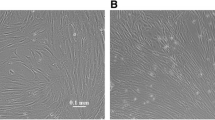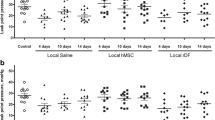Abstract
In this study, we describe a novel insight about the use of bone marrow-derived mesenchymal stem cells (BM-MSCs) for fallopian tube (FT) regeneration. Seventy rats’ tubes were involved in this study and divided into 4 groups: control (15), ethanol injured (20), mesenchymal stem cell (MSC)-recipient without injury (15), and MSC recipient after injury (20). The BM-MSCs were isolated from male rats, and their incorporation into the tissues was confirmed by the detection of Sry gene in MSC-recipient rats using RT-PCR. Histological and immunohistological sections of the 4 groups were comparably evaluated. We found that direct injection of ethanol into FT caused structural impairment, which was restored largely after receiving MSCs. We have revealed for the first time that prominin I (Prom I, stem cell marker) was expressed in the fimbriated distal tubal end. The MSC transplantation caused (1) significant increase in the tissue level and immunoexpresstion of Prom I (P <.001 and P =.017, respectively) and vascular endothelial growth factor (VEGF; vasculogenic marker; P <.001 and P =.004, respectively), (2) significant increase in the immunoexpresstion of proliferating cell nuclear antigen (PCNA; proliferation marker; P <.001), and (3) significant decrease in the immunoexpresstion of caspase 3 (CASP-3; apoptotic marker; P <.001) compared to the injured tissues. In conclusion, MSCs could exhibit its restorative effect on FT through their ability to (I) activate the resident stem cells in the distal tubal end, (2) mediate the expression of VEGF and PCNA, and (3) influence tissue apoptosis. This study laid the foundation for assessing the contribution of stem cells in the distal tubal end in direct repair of the tube when required to assist reproduction.
Similar content being viewed by others
References
Patil M. Assessing tubal damage. J Hum Reprod Sci. 2009;2(1): 2–11.doi:10.4103/0974-1208.51335.
Paik DY, Janzen DM, Schafenacker AM, et al. Stem-like epithe-lial cells are concentrated in the distal end of the fallopian tube: a site for injury and serous cancer initiation. Stem Cells. 2012; 30(11):2487–2497. doi:10.1002/stem.l207.
Patterson AL, Pru JK. Long-term label retaining cells localize to distinct regions within the female reproductive epithelium. Cell Cycle. 2013;12(17):2888–2898. doi:10.4161/cc.25917.
Wang Y, Sacchetti A, van Dijk MR, et al. Identification of quies-cent, stem-like cells in the distal female reproductive tract. PLoS One. 2012;7(7). doi:10.1371/journal.pone.0040691.
King SM, Hilliard TS, Wu LY, Jaffe RC, Fazleabas AT, Burdette JE. The impact of ovulation on fallopian tube epithelial cells: evaluating three hypotheses connecting ovulation and serous ovarian cancer. Endocr Relat Cancer. 2011;18(5):627–642. doi:10.1530/ERC-ll-0107.
Elfayomy AK, Almasry SM, El-Tarhouny SA, Eldomiaty MA. Human umbilical cord blood-mesenchymal stem cells transplan-tation renovates the ovarian surface epithelium in a rat model of premature ovarian failure: possible direct and indirect effects. Tissue Cell. 2016;48(4). doi:10.1016/j.tice.2016.05.001.
Minguell JJ, Erices A. Mesenchymal stem cells and the treatment of cardiac disease. Exp Biol Med (Maywood). 2006;231(1):39–49.
Ortiz LA, Dutreil M, Fattman C, et al. Interleukin 1 receptor antagonist mediates the antiinflammatory and antifibrotic effect of mesenchymal stem cells during lung injury. Proc Natl Acad Sci CX4. 2007;104(26):11002–11007.doi:10.1073/pnas.0704421104.
Zhao J, Zhang Q, Wang Y, Li Y. Uterine infusion with bone marrow mesenchymal stem cells improves endometrium thickness in a rat model of thin endometrium. Reprod Sci. 2015; 22(2):181–188.doi:10.1177/1933719114537715.
Marzesco AM, Janich P, Wilsch-Brauninger M, Dubreuil V, Lan-genfeld K, Corbeil D, et al. Release of extracellular membrane particles carrying the stem cell marker prominin-1 (CD133) from neural progenitors and other epithelial cells. J Cell Sci. 2005; 118(13):2849–2858.
Weigmann A, Corbeil D, Hellwig A, Huttner WB. Prominin, a novel microvilli-specific polytopic membrane protein of the apical surface of epithelial cells, is targeted to plasmalemmal protrusions of non-epithelial cells. Proc Natl Acad Sci USA. 1997;94(23):12425–12430.doi:10.1073/pnas.94.23.12425.
Badala F, Nouri-mahdavi K, Raoof DA. NIH Public Access. Computer (Long Beach Calif). 2008;144(5):724–732. doi:10.1038/ jid.2014.371.
Sagrinati C, Netti GS, Mazzinghi B, et al. Isolation and charac-terization of multipotent progenitor cells from the Bowman’s capsule of adult human kidneys. J Am Soc Nephrol. 2006; 17(9): 2443–2456. doi:10.1681/ASN.2006010089.
Fargeas CA. Prominin-1 (CD133): new insights on stem & cancer stem cell. Adv Exp Med Biol. 2013;777:25-40. doi: 10.1007/978-1-4614-5894-4.
Arndt K, Grinenko T, Mende N, Reichert D, Portz M, Ripich T. CD 133 is a modi fi er of hematopoietic progenitor frequencies but is dispensable for the maintenance of mouse hematopoietic stem cells. Pnas. 2013;110(14):5582–5587. doi:10.1073/pnas.1215438110/-/DCSupplemental. http://www.pnas.org/cgi/doi/10.1073/pnas.1215438110.
Shimizu T. Changes of messenger RNA expression of angiogenic factors and related receptors during follicular development in filts. Biol Reprod. 2002;67(6):1846–1852. doi:10.1095/biolreprod.102.006734.
Onda T, Honmou O, Harada K, Houkin K, Kocsis JD. Therapeutic benefits by human mesenchymal stem cells (hMSCs) and Ang-1 gene-modified hMSCs after cerebral ischemia. J Cereb Blood Flow Metab. 2008;28(2):329–340. doi:10.1038/sj.jcbfm.9600527.Therapeutic.
Connelly KM, Bogdanffy MS. Evaluation of proliferating cell nuclear antigen (PCNA) as an endogenous marker of cell proliferation in rat liver: a dual-stain comparison with 5-bromo-2’-deoxyuridine. J Histochem Cytochem. 1993; 41(1):1–6.
Munoz-Elias G, Woodbury D, Black IB. Marrow stromal cells, mitosis, and neuronal differentiation: stem cell and precursor functions. Stem Cells. 2003;21(4):437–448. doi: 10.1634/stem-cells.21-4-437.
Conget PA, Minguell JJ. Phenotypical and functional properties of human bone marrow mesenchymal progenitor cells. J Cell Physiol. 1999;181(1):67–73. doi:10.1002/(sici)1097-4652(199910) 181:1<67: aid-jcp7>3.0.co;2-c.
Fu X, He Y, Xie C, Liu W. Bone marrow mesenchymal stem cell transplantation improves ovarian function and structure in rats with chemotherapy-induced ovarian damage. Cytotherapy. 2008;10(4):353–363.doi:10.1080/14653240802035926.
Zarrow MX, Tochim JM, McCarthy JL, Sanborn RC. Experimental Endocrinology: A Sourcebook of Basic Techniques.. Academic Press; 1964. http://www.sciencedirect.com/science/book/9780123955661. Accessed March 9, 2017.
Fang B, Shi M, Liao L, Yang S, Liu Y, Zhao RC. Systemic infusion of FLK1(+) mesenchymal stem cells ameliorate carbon tetrachloride-induced liver fibrosis in mice. Transplantation. 2004;78(1):83–88. doi:00007890-200407150-00014 [pii].
Leite MC, Galland F, Brolese G, et al. A simple, sensitive and widely applicable ELISA for S100B: methodological features of the measurement of this glial protein. J Neurosci Methods. 2008; 169(1):93–99. doi:10.1016/j.jneumeth.2007.11.021.
S. Kim Suvarna, Christopher Layton JDB. Bancroft’s Theory and Practice of Histological Techniques. 7th Edition; 1989;53:160. doi:10.1017/CBO9781107415324.004.[AQ Please provide publisher details for Ref. 25.]
Almasry SM, Eldomiaty MA, Elfayomy AK, Habib FA. Expres-sion pattern of tumor necrosis factor alpha in placentae of idiopathic fetal growth restriction. J Mol Histol. 2012;43(3):253–261. doi:10.1007/sl0735-012-9410-6.
Nagori CB, Panchal SY, Patel H. Endometrial regeneration using autologous adult stem cells followed by conception by in vitro fertilization in a patient of severe Asherman’s syndrome. J Hum Reprod Sci. 2011;4(1):43–48. doi: 10.4103/0974-1208.82360.
Snegovskikh V, Mutlu L, Massasa E, Taylor HS. Identification of putative fallopian tube stem cells. Reprod Sci. 2014;21(12): 1460–1464. doi:10.1177/1933719114553448.
Auersperg N. The origin of ovarian cancers-hypotheses and con-troversies. Front Biosci (Schol Ed). 2013;5:709-719. http://www.ncbi.nlm.nih.gov/pubmed/23277080.
Kuhn E, Kurman RJ, Sehdev AS, Shih IeM. Ki-67 labeling index as an adjunct in the diagnosis of serous tubal intraepithelial carcinoma. Int J Gynecol Pathol. 2012;31(5):416–422. doi:10.1097/ PGP.ObO 13e31824cbeb4.Ki-67.
Cho KS, Park HY, Roh HJ, Bravo DT, Hwang PH, Nayak JV. Human ethmoid sinus mucosa: a promising novel tissue source of mesenchymal progenitor cells. Stem Cell Res Ther. 2014;5(1):15. doi:10.1186/scrt404.
Gargett CE, Masuda H. Adult stem cells in the endometrium. Mol Hum Reprod. 2010;16(11):818-834. doi:10.1093/molehr/ gaq061.
Marynka-Kalmani K, Treves S, Yafee M, et al. The lamina propria of adult human oral mucosa harbors a novel stem cell population. Stem Cells. 2010;28(5):984–995. doi:10.1002/ stem.425.
Salamonsen LA. Tissue injury and repair in the female human reproductive tract. Reproduction. 2003;125:301-311. doi:10. 1530/rep.0.1250301.
Indumathi S, Harikrishnan R, Rajkumar JS, Sudarsanam D, Dhanasekaran M. Prospective biomarkers of stem cells of human endometrium and fallopian tube compared with bone marrow. Cell Tissue Res. 2013;352(3):537–549. doi:10.1007/s00441-013-1582-1.
Shin SY, Lee JY, Lee E, et al. Protective effect of vascular endothelial growth factor (VEGF) in frozen-thawed granulosa cells is mediated by inhibition of apoptosis. Eur J Obstet Gynecol Reprod Biol. 2006;125(2):233–238. doi:10.1016/j.ejogrb.2005. 10.027.
Shyu WC. Intracerebral peripheral blood stem cell (CD34+) implantation induces neuroplasticity by enhancing betal integrin-mediated angiogenesis in chronic stroke rats. JNeurosci. 2006;26(13):3444–3453. doi: 10.1523/JNEUROSCI.5165-05. 2006.
Qin Z, Bai Z, Sun Y, Niu X, Xiao W. PCNA-Ub polyubiquitination inhibits cell proliferation and induces cell-cycle checkpoints. Cell Cycle. 2016;15(24): 1–12. doi:10.1080/15384101.2016. 1245247.
Nicolay NH, Ruhle A, Perez RL, et al. Mesenchymal stem cells are sensitive to bleomycin treatment. Sci Rep. 2016;6(May): 26645. doi:10.1038/srep26645.
Xu M, Uemura R, Dai Y, Wang Y, Pasha Z, Ashraf M. In vitro and in vivo effects of bone marrow stem cells on cardiac structure and function. J Mol Cell Cardiol. 2007;42(2):441–448. doi:10. 1016/j.bbi.2008.05.010.
Liang W, Lu C, Li J, Yin JQ, Zhao RC. p73alpha regulates the sensitivity of bone marrow mesenchymal stem cells to DNA dam-age agents. Toxicology. 2010;270(1):49–56. doi:10.1016/j.tox. 2010.01.011.
Author information
Authors and Affiliations
Corresponding author
Rights and permissions
About this article
Cite this article
Almasry, S.M., Elfayomy, A.K. & El-Sherbiny, M.H. Regeneration of the Fallopian Tube Mucosa Using Bone Marrow Mesenchymal Stem Cell Transplantation After Induced Chemical Injury in a Rat Model. Reprod. Sci. 25, 773–781 (2018). https://doi.org/10.1177/1933719117725824
Published:
Issue Date:
DOI: https://doi.org/10.1177/1933719117725824




